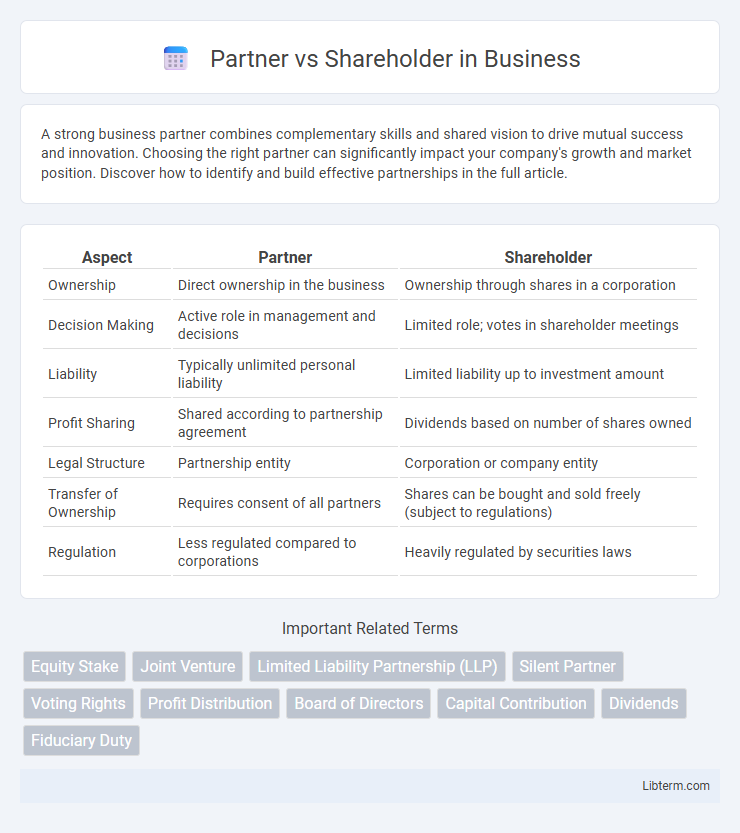A strong business partner combines complementary skills and shared vision to drive mutual success and innovation. Choosing the right partner can significantly impact your company's growth and market position. Discover how to identify and build effective partnerships in the full article.
Table of Comparison
| Aspect | Partner | Shareholder |
|---|---|---|
| Ownership | Direct ownership in the business | Ownership through shares in a corporation |
| Decision Making | Active role in management and decisions | Limited role; votes in shareholder meetings |
| Liability | Typically unlimited personal liability | Limited liability up to investment amount |
| Profit Sharing | Shared according to partnership agreement | Dividends based on number of shares owned |
| Legal Structure | Partnership entity | Corporation or company entity |
| Transfer of Ownership | Requires consent of all partners | Shares can be bought and sold freely (subject to regulations) |
| Regulation | Less regulated compared to corporations | Heavily regulated by securities laws |
Introduction: Understanding Partners and Shareholders
Partners share ownership and management responsibilities in a business, often collaborating actively in decision-making and profit-sharing, typically in partnerships like LLPs or general partnerships. Shareholders own shares in a corporation, holding equity but usually limited to voting on major corporate decisions without involvement in daily operations. Understanding these roles highlights key differences in liability, control, and organizational structure between partnerships and corporations.
Definition of a Partner
A partner is an individual or entity that jointly owns and operates a business under a partnership agreement, sharing profits, losses, and management responsibilities. Unlike shareholders who own shares in a corporation without direct involvement in daily operations, partners actively participate in decision-making and are personally liable for the business's debts. Partnerships often require mutual trust and collaboration, defining roles and contributions through a legal partnership contract.
Definition of a Shareholder
A shareholder is an individual or entity that owns shares in a corporation, representing partial ownership and entitlement to a portion of the company's profits through dividends. Shareholders hold equity in the company and have voting rights that influence major corporate decisions during shareholder meetings. Unlike partners in a partnership, shareholders are typically not involved in the day-to-day management of the company but benefit financially from its success and bear risk proportional to their shareholding.
Key Legal Differences
Partners in a business operate under a partnership agreement, sharing unlimited liability for debts and obligations, whereas shareholders have limited liability confined to their investment in the corporation. Partners participate directly in management decisions unless otherwise agreed, while shareholders typically exert control through voting rights in board elections without day-to-day management roles. Legally, partnerships dissolve upon a partner's withdrawal unless otherwise stipulated, whereas corporations continue regardless of shareholder changes due to separate legal entity status.
Roles and Responsibilities
Partners actively manage the business, sharing profits, losses, and decision-making responsibilities, often contributing capital and expertise. Shareholders primarily invest capital in a corporation, receiving dividends based on ownership percentage, but they typically do not engage in daily operations or management. The key distinction lies in partners' direct involvement in running the business, whereas shareholders hold ownership rights without operational control.
Ownership Structure
Partners in a business share ownership based on their partnership agreement, typically involving equal or negotiated equity stakes reflecting their roles and contributions. Shareholders own a corporation through shares of stock, where ownership percentages correspond to the number of shares held, influencing control and profit distribution. The ownership structure for partners is often more flexible and personal, while shareholders' ownership is formalized, transferable, and regulated by corporate law.
Profit Sharing and Losses
Partners share profits and losses according to the terms specified in the partnership agreement, often reflecting their capital contributions or agreed-upon ratios. Shareholders typically receive dividends based on the number of shares owned, with losses absorbed by the corporation and not directly impacting individual shareholders' personal assets. Unlike shareholders, partners have joint liability for business losses, making them personally responsible beyond just profit sharing.
Decision-Making Powers
Partners possess direct decision-making powers in managing the business, often participating equally in strategic and operational choices based on the partnership agreement. Shareholders typically hold voting rights proportional to their shares, influencing major decisions like electing the board of directors or approving mergers but rarely engaging in daily operations. The distinction lies in partners' active management roles versus shareholders' more limited, investment-oriented control.
Liability and Risk Involvement
Partners in a business typically face unlimited liability, meaning they are personally responsible for all debts and obligations incurred by the partnership, increasing their financial risk exposure. Shareholders, on the other hand, enjoy limited liability, where their risk is confined to the amount invested in the company's shares, protecting personal assets from company debts. This fundamental difference in liability significantly impacts the level of risk involvement and financial accountability each party assumes in a business structure.
Choosing Between Partnership and Shareholding
Choosing between a partnership and shareholding depends on the desired level of control, liability, and profit distribution. Partners share unlimited liability and direct management responsibilities, while shareholders enjoy limited liability and ownership through shares without daily operational involvement. Understanding these distinctions helps businesses align their structure with financial goals and risk tolerance.
Partner Infographic

 libterm.com
libterm.com